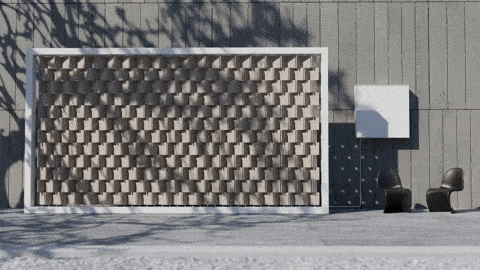
The number of wind turbines across the world has grown exponentially thanks to plummeting costs. By now, people have grown accustomed to huge wind turbine farms that dot some landscapes, either onshore or offshore. But unlike solar panels, residential wind turbines are less affordable and accessible, being seen as too cumbersome and wind-dependent, and this is most evident in urban areas. You’ll be hard-pressed to find wind turbines in Manhattan, whereas rooftop solar installations abound.
It’s this predicament that inspired designer and entrepreneur Joe Doucet to fill the gap in our renewable energy generation toolkit with an out-of-the-box solution: rather than harnessing the wind with huge blades suspended on tall towers, Doucet invented a flat wind turbine that can be incorporated into walls.
The turbine wall is made up of a grid of square panes that spin along 25 axes. The first prototype consists of 25 wind turbine generators that are already commercially available, which are attached to 25 corresponding vertical rods with square panels attached alongside them to capture wind pressure.
The prototype wall measures 25 feet (7.5 meters) in length and 8 feet (2.5 meters) in height but can be scaled to virtually any dimension. For instance, one such modular panel could be interconnected with others like it, the same way we now use individual solar panels to cover a rooftop.
And although it may look like a fancy kinetic art installation, Doucet claimed in an interview with Fast Company that an average American home with one side covered by a turbine wall could meet its yearly energy needs (10,000 kilowatt-hours/year). That’s based on simulations that are obviously subject to great fluctuations depending on how much wind hits the turbines. These results have not been verified or peer-reviewed by independent sources, so one should take these claims with a grain of salt. In urban settings, turbulent winds are dampened by tall buildings and other obstructions and real-life applications may render very different results from these simulations.
Where Doucet imagines his invention flourishing is in large-scale commercial buildings, such as malls, office buildings, and supermarkets — even inside busy and crammed cities. Conventional wind turbines take up a lot of real estate, can be noisy, and are seen as eyesores and obstructions to the visual landscape, which have made them unappealing in urban settings. Wall turbines may prove to be an acceptable compromise — that’s if they don’t hypnotize people with their revolving panels.
What’s more, the turbine walls, whose turbines are made of aluminum, could also dot roads and highways, taking advantage of the air pressure generated by traffic.
“Instead of the typical retaining walls along roads and freeways, you’d have an array of these,” Doucet told Fast Company. “With the added wind boost from trucks, our highways could take care of all our energy needs.”
Doucet is currently hammering out deals with several manufacturers to bring his prototype to the market. In combination with solar panels, these turbine walls could greatly lower our urban carbon footprint.
This article originally appeared in 2021.






